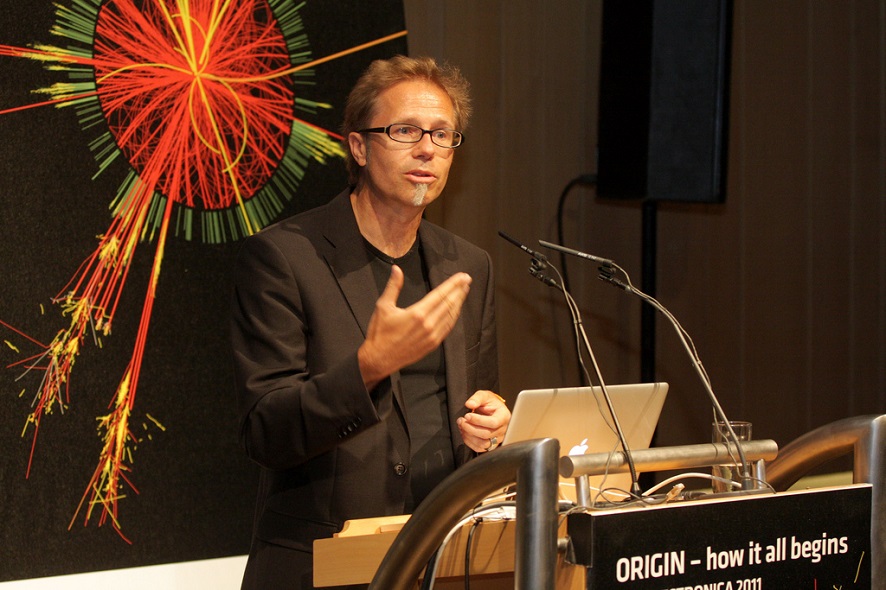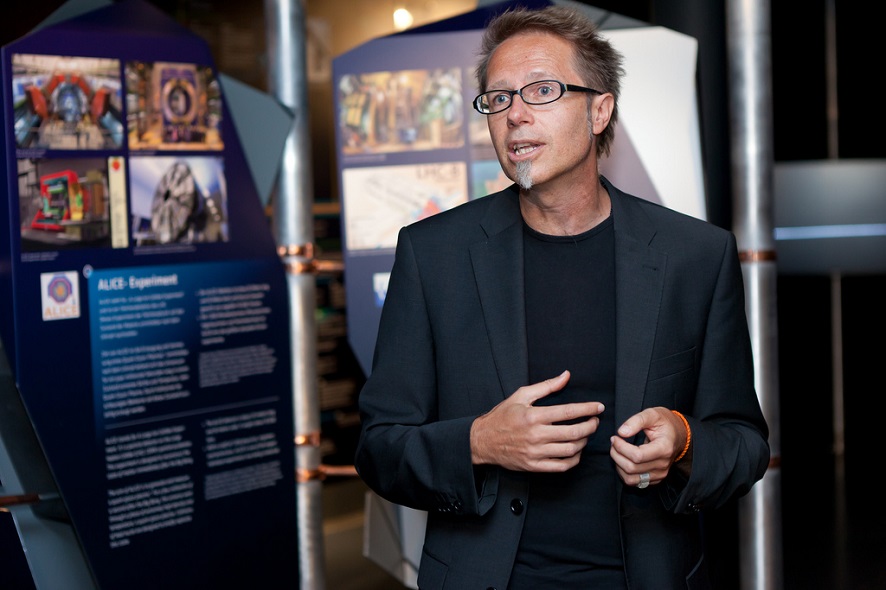“The fear of committing an error is not a source of good advice when it comes to exploring new frontiers,” is the conviction of Michael Doser, a physicist at the European Organization for Nuclear Research (CERN) in Geneva, Switzerland. Errors open up new possibilities and just might lead to new discoveries. And, needless to say, in science, they occur on a daily basis.
So, the question is: How do you deal with it when an experiment flops or a theory is disproved? And precisely that is the course of study at the Ars Electronica Festival’s Academy of Error. In line with this year’s festival theme, Error – the Art of Imperfection, scholars from all over the world will gather to discuss what errors can lead to in scientific research. This conclave is set for Sunday, September 9th from 10:30 to 12:30 in the Conference Hall at POSTCITY Linz; the general public is cordially invited to attend. Michael Doser will chair the discussion. Here, he talks about errors in research, norms in the field of antimatter, and the concept of perfection.
You’re Chairman of the Academy of Error at this year’s Ars Electronica Festival, where participants will reflect on how scientists deal with errors. What role does error play in science?
Michael Doser: Chairman of the Academy of Error—what a wonderful job title. I should have that on a bronze plaque on my office door!
As chairman, one must often set the course, occasionally reestablish some form of balance, and, above all, see to it that the necessary resources are available and optimally distributed—establish an error budget, so to speak. I thus have to make sure that all participants make the same number of mistakes, or rather are disrupted at the same rate and, ideally, taken aback to a certain extent. An error is, on one hand, the unintended and unexpected that can lead to a “scratching of heads” and discoveries; on the other hand, it’s an intentional search for places at which currently accepted explanations break down, lose their validity, and a more comprehensive insight can emerge.
Anyway, “error” encompasses too many concepts— mistakes, measurement inaccuracies, blinders, mix-ups, bias, defectiveness, imprecision, disturbance, perturbation… so, which error are we talking about?
Theories that predict that which has not been observed are at least faulty and possibly also false, unless the measurement is erroneous or perhaps a sheer impossibility. Likewise theories that don’t predict that which was just measured—or seems to have been measured, which can, in turn, mean a reprieve for the theory. But even a faulty observation can engender new ways of looking at things. A statistical fluctuation in the measured data from the LHC [Large Hadron Collider] two years ago, which disappeared in the subsequently acquired larger data set, had induced, in the meantime, hundreds of theoretical developments that, naturally, all ultimately explained a non-existent signal, but perhaps a couple of which—slightly modified—then nevertheless come closer to reality than all the attempts made heretofore. Then again, maybe they’re all wrong.

Conference Hall at the Ars Electronica Festival. Credit: Robert Bauernhansl
The same applies to incompatible theories that attempt to explain the same observation (and who says that Ockham’s Razor isn’t occasionally a murder weapon that kills the wrong victim?). Now, whether dark matter (as weakly interacting particles? Or as massive objects?) or a modified theory of gravity is the correct explanation is a wide-open question. The competition between different models, of which at most one can be true, nevertheless invigorates theory, experimentation and observation, which share the common aim of finding a possibility for differentiation and verification.
But how does one go about defending the necessity of making mistakes if mistakes aren’t automatically productive and can, obviously, also lead to failure? Not errors due to stupidity or hubris, but rather because the new course, the path that had never been taken, turned out to be a miscalculation or a dead end? But not permitting such errors to be made means only working incrementally, optimizing what’s already known, and not allowing a fundamentally new development to happen. The fact that a step in a new direction constitutes a risk—to wit, that this step could either fail or turn out to be unproductive—ought not be grounds to not occasionally dare to take such a step. The fear of committing an error is not a source of good advice when it comes to probing new frontiers and discovering new territory; at the same time, not every expedition proposing to find a shortcut to India is worthy of support. This is an argument for a not excessively but rather sensibly funded error budget.
At the festival, we’re focusing on error as a deviation from the norm. What sort of deviations are to be found in your field, antimatter, and how can one nevertheless gain insights from them?
Michael Doser: In the field of antimatter, the norm is symmetry, the same properties for particles and antiparticles, and thus, since the Big Bang, an identical occurence of matter and antimatter. That’s also the way it looks in the lab according to the most precise measurements possible, and those measurements are extremely exact at this point. The deviation from the norm, on the other hand, is maximal—a total absence in the visible universe of the antimatter produced by the Big Bang. The insight here is that the norm is false, that symmetry breaking has to have occurred, that the model absolutely must provide for a crack, which, despite intensive efforts, has not yet been found. And perhaps this will lead to another new insight—that we might not be in a position to ever be able to solve this problem… and thus, a confrontation with the limits of our knowledge.
Could you tell us about an error you made in your research or scholarly career—hypotheses that didn’t pan out or theories that collapsed?
Michael Doser: The classic example in particle physics is mirror symmetry, which posits that what we see in the mirror constitutes an extant reality to the exact same extent as that which is reflected in the mirror. A ball falls from a tower; its reflection falls in the exact same way. A top spins clockwise; its reflection spins counterclockwise, but a top spinning counterclockwise can be described in exactly the same way as one spinning clockwise; the same physics apply to both.
And that’s why, for a very long time, scientists proceeded under the assumption that all physical processes are symmetrically identical. Until 1956, when physicist Chien Shiung Wu, encouraged by theoreticians Lee and Yang, observed the nuclear decay of Cobalt 60 and came to the conclusion that, in this case, the mirror symmetry is broken—these nuclei behave like tops spinning clockwise, and, when decaying, emit electrons in the direction of their angular momentum, upwards. The mirror-image process—that is, tops spinning counterclockwise that would likewise emit electrons upwards—does not occur. Thus, contrary to the very strong expectations of the most renowned physicists of that day, mirror symmetry was broken. T.D. Lee wrote in March 1966: “The more we learn about symmetry operations — space inversion, time reversal and particle–anti-particle conjugation — the less we seem to understand them. At present, although still very little is known about the true nature of these discrete symmetries, we have, unfortunately, already reached the unhappy state of having lost most of our previous understanding.” This assessment still pretty much holds true 50 years later.
As for myself, I’m seeking a symmetry breaking like this in another area, gravity, which would however contradict an incredibly solid theory, the General Theory of Relativity. This is a targeted search for an error that probably doesn’t even exist, and using a method that, in comparison to other approaches, might very well turn out to be a mistake.

Michael Doser at the 2011 Ars Electronica Festival. Credit: rubra
Talk about the Art of Imperfection—how do you go about your work knowing full well that so much will not be understood?
Michael Doser: I believe that anyone who expects conclusive answers won’t be happy in science. Quite the contrary—you have to derive a certain pleasure from the impermanence of knowledge, and be driven by a desire to, if not get imperfection completely under control, then at least to restrain it to some extent. An estimation of the inexactitude with which an answer is obtained is inseparable from the determination of the measured magnitude itself. Such a quantification of ignorance is, on one hand, the crowning achievement of the often extremely elaborate effort it takes to make such a measurement; on the other hand, it’s an incentive to further develop technology and science to better shed light on the causes of the uncertainties and to reduce them.
Do you believe in chance?
Michael Doser: Of course! Even if an experimental physicist is incessantly tempted to assume that nature is malicious or at least cunning when, yet again, a power failure occurs in the middle of a measurement. I say “Of course” simply on account of the probabilistic nature of events on the quantum level – deterministic explanations have long since been convincingly excluded from the realm of possibility, while the possible loopholes have become fewer and fewer and, at the same time, increasingly exotic. But also because, in an extraordinary number of cases, coincidence has pointed the way to discoveries and to new research approaches. Be that as it may—the capacity to recognize and exploit these happenstances seems to require a very good preparation, a deep insight into a given field and an intensive involvement with the problem to be solved.
Can it be maintained that something like perfection even exists in the universe?
Michael Doser: The anthropic principle considers the universe as, more or less, the best of all possible worlds, at least from an anthropocentric point of view, of course—which, considering the many currently seemingly “kludged” parameters such as coupling constants or masses, constitutes, now and in the foreseeable future, either the pinnacle of our understanding of the universe (and thereby depressingly attests to the poverty of our intellect), or illuminates the extent of our ignorance (and thus constitutes almost equally depressing testimony to the poverty of our intellect, though with a tiny shimmer of hope in this instance).
But what does perfection actually mean? Is an absolutely precisely balanced needle that doesn’t tip over perfect? A clockwork that runs perpetually at the same rate? Or might it actually be this messy reality with its manifold possibilities and potential developments? A reality that permits this uncertainty in which developments are open and that, due to its built-in possibilities for interconnections at every level, allows for infinite combinations, very closely approaches my conception of perfection.

Michael Doser is a physicist at CERN, the European Organization for Nuclear Research, in Geneva, Switzerland. His specialty field is antimatter. He’s currently working on the formation of antiatoms, the search for an explanation of matter-antimatter asymmetry, and the measurement of the gravitational interaction between matter and antimatter. He is the official speaker for CERN’s AEgIS experiment, gives lectures on antimatter, and is a regular contributor to Physics Letters B and the Review of Particle Properties.
The Academy of Error is scheduled for Sunday, September 9, 2018, 10:30 to 12:30 in the Conference Hall at POSTCITY Linz. Michael Doser will moderate a discussion among leading experts in science and research.
To learn more about Ars Electronica, follow us on Facebook, Twitter, Instagram et al., subscribe to our newsletter, and check us out online at https://ars.electronica.art/news/en/.
